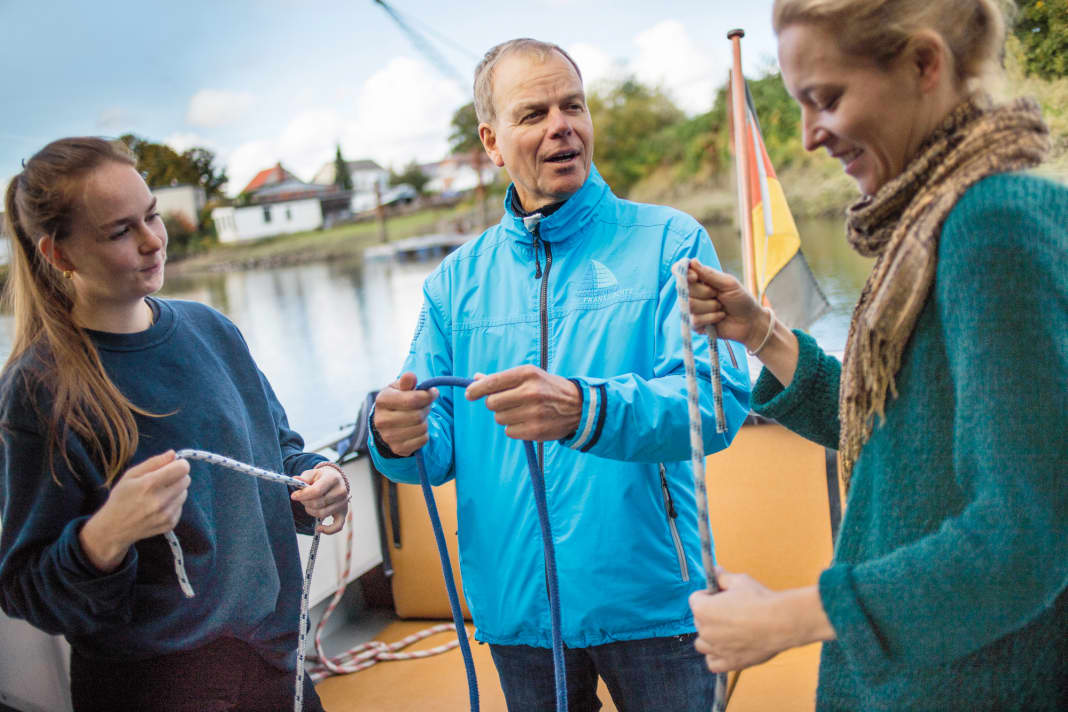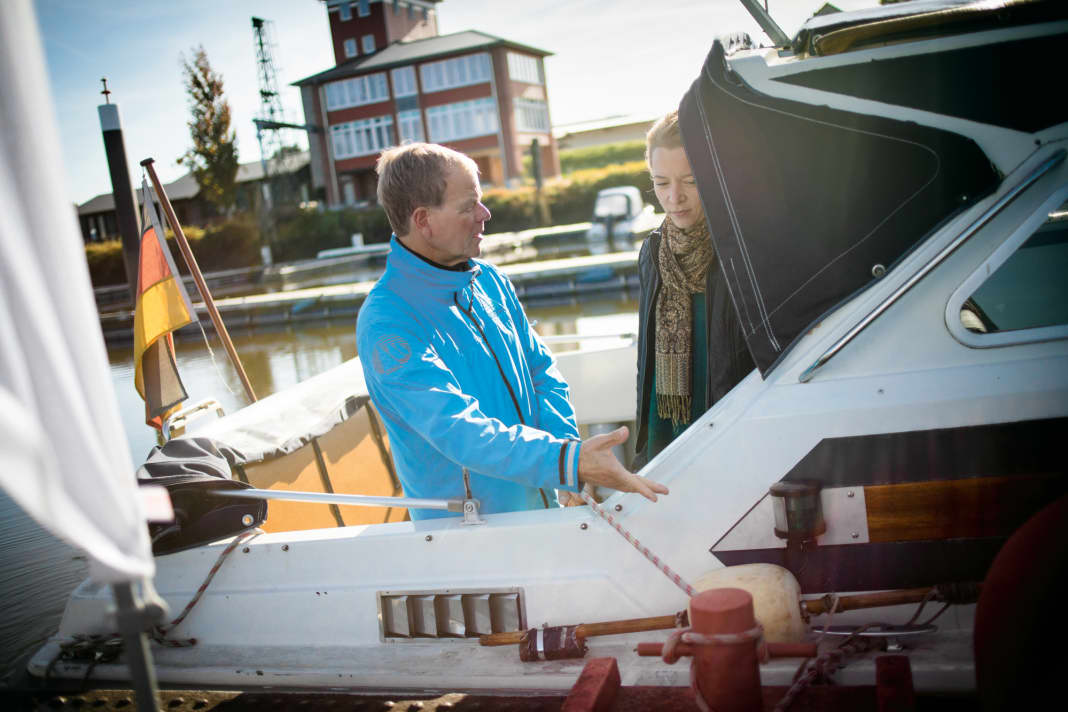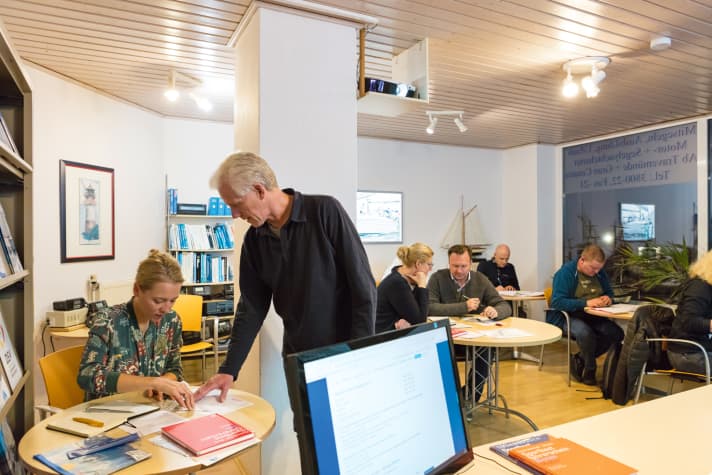





When my course material arrives at home and I open the textbook for the first time, I suddenly feel like I've been transported back to my school days. I see mathematical formulae and problems - not exactly my strong point even back then. Nevertheless, over the next eight weeks, I'm going to try to acquire nautical expertise that was previously completely foreign to me. Determined, but also with a good deal of respect for the upcoming exams, I registered for my sailing licence at the Frank Lochte sailing school in Lüneburg. When I finally got my long-awaited university diploma a few years ago, I was actually relieved that I would never have to study for an exam again. But for the prospect of no longer just sailing along, but being allowed to skipper myself, I'm happy to go back to school.
The basics of navigation
Frank Lochte starts with the basics of navigation: What is a nautical mile and what is the nautical unit of knots derived from? How can I orientate myself on a nautical chart with latitude and longitude and how do I calculate distances, courses and speeds? For someone like me, with no previous knowledge and a certain aversion to anything to do with numbers and calculations, it's quite a lot to begin with. So I'm all the more surprised that I actually enjoy working with triangles and compasses on the nautical chart.
The biggest surprise for me as an absolute beginner: in contrast to the car driving licence, practice only plays a minor role in the recreational boating licence. I sit in theory lessons every Tuesday evening for eight weeks, work through every single exam sheet at home and practise with the accompanying app on my mobile phone every free minute. But I'm only on the water once: a week before the practical test, I'm at the wheel and try to memorise what my driving instructor explains to me about the five compulsory manoeuvres that need to be completed.
The day of the exam
On the day of the test, the weather is on my side: the sun is shining and there is not a breath of wind. Perfect conditions to show the examiner that I can dock and cast off and manoeuvre a boat without ramming the jetty and sinking surrounding boats. Nevertheless, I'm nervous as I wait my turn at the jetty with my ropes in hand. Every fifteen minutes, one skipper candidate after the next is tested here today. As I climb on board, my legs feel pretty wobbly despite the lack of swell. I'm simply not used to exam situations any more. Surprisingly, my slightly shaky hands still manage to tie all the important knots in front of the examiner. The point is already in the bag. It's off to the wheel. Nervous, I pull the gear lever back a little too hard and the engine howls briefly.




But then everything goes smoothly. Casting off, sailing by compass, taking bearings, buoy overboard, even the mooring manoeuvre that most people dread goes like the textbook. Done! But the biggest challenge still lies ahead of me. I have to learn to learn again. Acquiring new knowledge is a matter of practice - and I'm pretty out of shape. Multiple choice sounds like a huge relief at first, I think. Unlike in the past, you no longer have to formulate the answers yourself, but have four possible answers per question and can work according to the principle of elimination. And even if you don't know the answer at all, there is still a 25 per cent chance of getting it right by mistake. But I soon realise that it's not as easy as it sounds. The answers are often so similar that you have to read through them very carefully to recognise the small but crucial difference.
Rules, signs and signals are tested in the recreational boating licence test
Sometimes they only differ in one word. What's more, a lot of the collision prevention rules are completely new territory for me. In road traffic, I was already familiar with most of the rules and signs from everyday life when I took my car driving test. However, I encountered sound signals and light guidance for the first time when I was preparing for my pleasure craft licence.
A great help here is the SBF app from Delius Klasing. It offers a learning section, a practice section and an exam simulation, each for the different types of driving licence. In contrast to the classic paper practice sheets, where you only see which questions you have answered incorrectly when you take the test, the app corrects you immediately and repeats the relevant questions using the index card system until you get it right three times. In this way, the newly acquired knowledge is reliably memorised step by step. In total, the examination question catalogue includes 72 basic questions, which are the same for the SBF Binnen and SBF See, 181 specific Binnen questions and 213 specific See questions as well as 15 additional navigation tasks, each with nine subtasks. Quite a lot of material. Too much for thirteen per cent of candidates: that's the average failure rate.

In the theory test, 30 multiple-choice questions must be answered within 60 minutes. You pass if you answer five of the seven basic questions and 18 of the 23 specific inland or sea questions correctly. The SBF See also includes the navigation section, which consists of nine subtasks, at least seven of which must be answered correctly. Each examination sheet for the SBF See also contains a section of a nautical chart. The tasks here range from simply reading off a distance to calculating displacements.
Costs for a recreational boating licence
The cost of a recreational boating licence varies greatly and depends on several factors. There are weekly evening courses, weekend crash courses and purely self-study online courses. This also determines how long it takes until you finally have your licence in your pocket. The cost of practical training also varies from driving school to driving school, depending on whether you need additional practice hours.
Added to this are the costs for teaching materials, navigation equipment and the medical certificate, which certifies hearing and sight, as well as the examination fees. All in all, you can expect to pay around 300 euros, but can also spend up to 800 euros, depending on what you decide on and how long you ultimately need. Almost two and a half months after my first theory lesson, I'm sitting in the basement of the town hall with many other candidates, opening my exam sheet. With every tick I make, the weight on my shoulders decreases. And my feeling is not wrong. On the same day, I receive the news that I have passed.
My conclusion: Yes, it's a lot of material, but if you take your time, you can easily manage it, even without any previous knowledge. Two weeks after the exam, it arrived in my letterbox: my recreational boating licence in practical cheque card format. Now I'm officially allowed to go boating on my own. Whether I can really do it remains to be seen. But, as we all know, practice makes perfect.
Designations of recreational craft licences
The official names of the official licences to operate a recreational craft are "Sportbootführerschein mit Geltungsbereich Binnenschifffahrtsstraßen", or SBF Binnen for short, and "Sportbootführerschein mit Geltungsbereich Seeschifffahrtsstraßen", or SBF See for short. With the SBF Binnen, you are allowed to operate non-commercially used vessels of less than 20 metres (less than 15 metres on the Rhine) on inland waterways. The SBF See is valid for sport and leisure purposes and only within the scope of the Seeschifffahrtsstraßen-Ordnung, which includes the three nautical mile zone on maritime waterways and fairways within the twelve nautical mile zone.

